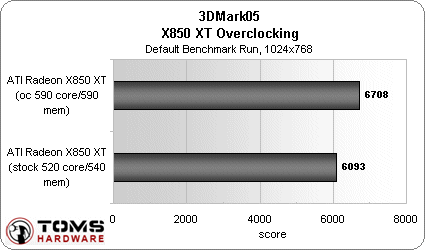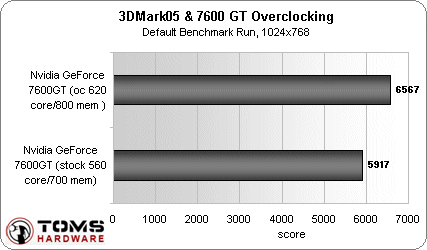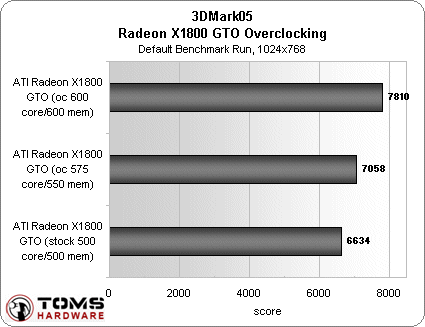Sub $200 PCI Express Graphics Card Showdown
Overclocking And Moddability
Now that we know how these cards perform in their stock configurations, let's have a look at how they do when pushed past their usual limits.
The Radeon X850 XT was a pretty good overclocker, considering its older 130 nm manufacturing process. We were able to take it up 70 MHz on the core and 50 MHz on the memory with no trouble, simply by using the ATITool utility. This gave us a 615 point increase in 3DMark, which is about a 10% increase in performance... not bad at all.
The GeForce 7600 GT was also friendly to overclocking efforts. Using Rivatuner, we managed to get an additional 60 MHz on the core and an impressive 100 MHz on the memory. That translated to 650 points in 3DMark, or about an 11% increase in performance - very similar to the results achieved with the X850 XT.
With the X1800 GTO, we overclocked simply using ATI's 'Overdrive' utility, which is built directly into ATI's Catalyst drivers. The drivers control the maximum overclocking allowed, so our efforts were limited to 75 MHz on the core and 50 MHz on the memory. Even with these modest increases, the X1800 GTO edged past 7000 3DMarks, a 6% increase over stock.
With the X1800 GTO, it was possible to go even further. The Radeon X1800 has the most overclocking headroom of the three cards without physically altering the hardware (using soldering or shorting bridges). This is because ATI's Radeon X1x00 series can be voltage controlled within software.
There are two complications involved in getting this feature to work, unfortunately. The first relates to the X1800 GTO's BIOS. The only software available to control Radeon X1000 voltages is ATITool, and the newest version was released before the X1800 GTO was available. To get it to work, the X1800 GTO BIOS has to be flashed, and flashing a video card BIOS is not something to take too lightly. For those interested in the method, I will post a quick guide in the forums thread link at the end of this article.
The second complication involves the "ATI Hotkey Poller" and "ATI Smart" services, which have to be disabled. These services detect if a 3D application is running, and if it isn't, they throttle back video card clock speeds to conserve energy and reduce heat. Unfortunately, these applications do not work with overclocking applications like ATITool, so they have to be turned off before proceeding.
Get Tom's Hardware's best news and in-depth reviews, straight to your inbox.
Once these tasks are done, however, the results are rewarding. A slight voltage increase of 0.75 V on the core and 0.055 V on the memory resulted in a 100 MHz increase on both the core and memory speeds, allowing for a 3DMark score of 7810. That's more than a 16-pipeline X1800 XL scored on the test bed - it's closer to X1800 XT territory! In numeric terms it is an increase of 1176 points over stock, or about 18%.
Another note about the X1800 GTO: unlike the X850 XT and 7600 GT, these cards are running a GPU with four of the 16 pipelines disabled. Some cards can have this process reversed with a simple X1800 XL BIOS flash, so the card uses a full 16 pipelines. I didn't try to unlock the reference X1800 GTO - because we don't want people to assume it works all of the time - but it is something that modders might want to keep in mind. Certain manufacturers' X1800 GTOs have a better chance to unlocking than others, and this might be something to investigate if you're interested in going this route.
Finally, I'd like to point out that if you're not intimidated by soldering or shorting out bridges on your video card, the 7600 GT and even the X850 XT have more overclocking potential when voltage is modified. But if you're shy about messing around with the components, the X1800 GTO is probably your best choice.
Current page: Overclocking And Moddability
Prev Page OpenEXR HDR And Anti-Aliasing At The Same Time? Next Page ConclusionDon Woligroski was a former senior hardware editor for Tom's Hardware. He has covered a wide range of PC hardware topics, including CPUs, GPUs, system building, and emerging technologies.


